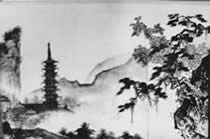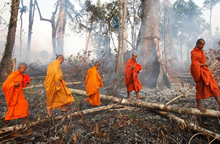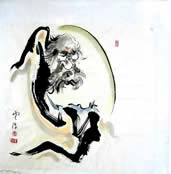 |
 |
 |
Buddhism’s Origin in the Heart of Nature
By Dr. Charles S. Fisher
Published 2014
In ancient India the Buddha began his search into the meaning of life by going off to the woods to seek relief from the suffering that humans inevitably experience. It was while meditating under a tree that the Buddha was awakened. He called the earth to witness the sincerity of his endeavors.
The image of a forest meditator has been prominent in Buddhism for the last two thousand years. The Buddha felt that the wilds would tear away the veils of civilization and allow sincere seekers to see more deeply into the character of human suffering and its surcease. Meditation in the Wild explores the history of forest meditation since the time of the Buddha. It presents what we know of the Buddha’s forest sojourn and those disciples in ancient India, China Japan and Southeast Asia who went into the wild emulating him. It looks at the resistance of the Buddhist establishment and how one might meditate in the wild today. Each place where forest practice was undertaken presents a different natural environment and different understandings of nature and meditation practice.
“An exciting portrait of how the Buddha and meditators since his time have gone back into raw nature to try to understand themselves and humanity’s place in the world.”
Jack Kornfield, guiding teacher of the Spirit Rock Meditation Center and author of many books on meditation.
“An astonishing fusion of interpretation and inspiration distilled over a lifetime of study of both natural history and the Buddhist dharma.”
Wade Davis, National Geographic Explorer in residence and author of Into the Silence, One River, and The Serpent and the Rainbow.
“As Buddhist meditation becomes ever more widely practiced today, it is vital to recognize its intimate connection to the natural world. In returning us to the sources of the tradition, Charles Fisher’s timely book affirms how mindfulness is inseparable from a heightened awareness of the sublime and fragile environment of which we are inextricably tied through every breath we take.”
Stephen Batchelor, author of Confession of a Buddhist Atheist.
“….nature is fundamentally unreliable, mostly uncomfortable. Nature is too cold, too hot, too windy. It opens us to what is. That is the Dharma. We work with that.” This is just one of many kernels of wisdom Charlie Fisher reveals for us in his astonishing distillation of Buddhism’s fundamental connection to the natural world. For those who care about the environment, this book is an important reminder of the need for frequent, contemplative reconnection with nature in order to best protect it.”
Jon Miceler, Managing Director, Eastern Himalayas Program, Director, Mainland Asia Program, World Wildlife Fund.
“Meditation in the Wild: Buddhism’s Origin in the Heart of Nature follows up on Fisher’s earlier Dismantling Discontent: Buddha’s Way through Darwin’s World,which showed how Buddhism didn’t come out of nowhere but was a measured response to restore a natural animal being in a world that had been truncated–phenomenologically bulldozed–in the wake of encroaching civilization. Meditation in the Wild backs up and extends that most credible thesis, but here he zeros in on centuries of Buddhist adepts, forest monks and mountain meditators whose varied practices illuminate the historical roots and natural context of the practice that Alan Watts called the no-religion religion. Studded with poetry, historical details, and level-headed analysis, Fisher again proves a most credible guide to the modern relevance of an ancient tradition.”
Dorion Sagan, science writer, author of Notes from the Holocene and Cosmic Apprentice.
“Intriguing and insightful, Meditation in the Wild hits a sweet spot between Buddhism and the environment. Charlie Fisher asserts that Buddhist practice must be understood in the context of closeness with wild nature – the context in which Buddha himself attained enlightenment. As a professor and a scholar, Charlie has clearly broken new ground. Through a detailed exploration of he writings and stories of past Buddhist masters, he reveals the details of how wild nature aided their quest for enlightenment. As a man (and longtime meditator) who has himself lived close to the wilderness much of his life, Charlie’s authentic connection to the wild shines through on every page, especially as he describes his close encounters with bears and wolves. The teaching tools of the wild are sometimes harsh: fear, cold, hunger, loneliness. Yet from them the sages learned to let go of ego, cease grasping, and find their place in the natural world. It’s a lesson all humanity must take to heart.”
Tim Ward, author of What the Buddha Never Taught: a “behind the robes” account of life in a Thai forest monastery.
Comments on Dismantling Discontent:
“A very absorbing read…with an unusual and provocative thesis juxtaposing Darwin and Buddha. [Fisher] probes behind the surface with data from animal and human societies and neurological findings to explore the existential dilemma that Buddha proclaimed in the four signs: illness, old age, death and transcendence of these in the yellow robed renouncer.”
Gananath Obeyesekere, Professor Emeritus of Anthropology, Princeton University and author of Imagining Karma and The Awakened Ones
* Sesshu’s “Long Scroll” from an uncopyrighted Chinese reproduction. “Bodhidharma” by permission of the owners. And Monks walking in a devastated Cambodian forest. Photo: Luke Duggleby/www.lukeduggleby.com
